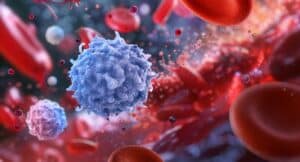Cell death is a physiological, healthy part of maintaining equilibrium within the body. In fact, about a billion cells die in our bodies every day, largely due to a programmed cellular maintenance process called apoptosis. That process eliminates unwanted cells, including those cells that could lead to tumor development. However, some cell death has negative consequences, including tissue damage. Pyroptosis is one such form of cell death, resulting from pathogenic or inflammatory activity. But one recent study explored pyroptosis from a positive perspective, with an unexpected result: The study revealed that pyroptosis can actually play a crucial role in promoting healing and tissue repair. This research, published in Nature, could lead to innovative treatments for wounds and inflammatory diseases, helping researchers better understand how the human body responds to injury and chronic inflammation.
How Pyroptosis Fuels Inflammatory Diseases
“Inflammation” is a bit of a loaded term in today’s medical discourse. However, not all inflammation is inherently negative. When faced with an infection, our bodies launch an immune response — a response that results in inflammation. The inflammation generally clears the infection and resolves on its own in a timely manner. However, when inflammation is not resolved properly, it can have negative consequences. One such consequence is pyroptosis, a destructive form of cell death.
While pyroptosis originates as a positive process — it induces significant inflammation in an attempt to help the body clear infections — it ultimately has a harmful effect, causing severe tissue damage. However, the new research mentioned above led to the discovery of something surprising: pyroptotic cells also release molecules that can encourage wound healing in the surrounding tissue. To reach this finding, the research team employed a number of mouse model systems.
Exploring Pyroptotic Cells in Mouse Models
The research, led by Professor Kodi Ravichandran of the VIB-UGent Center for Inflammation Research, used mouse model systems to examine the molecules secreted by pyroptotic cells. Upon close inspection, the team was surprised to find that the molecules secreted by pyroptotic cells induce significant gene expression changes in nearby healthy immune cells. Those changes were, surprisingly, positive. The team found that the molecules promoted healing and tissue repair — a finding that goes directly against the previous understanding of pyroptotic cells as generally negative. The team found that pyroptosis “presses both the accelerator and the brake,” causing inflammation while also helping nearby tissue to heal itself.
“Our experiments revealed that the secreted molecules from dying cells, known as the pyroptotic secretome, can significantly boost the body’s ability to repair damaged tissues even when inflammatory molecules are present,” wrote co-author Dr. Sophia Maschalidi. In other words, the dying cells can help heal the body, even as they wither.
Identifying Essential Wound-Healing Molecules
One of the key wound-healing molecules within pyroptotic cells is prostaglandin E2, also known as dinoprostone. This molecule type is known specifically for its role in pain and tissue regeneration. Medical researchers may have previously promoted treatments that blocked pyroptosis; however, understanding the role of molecules like prostaglandin E2 could lead to a different approach. While blocking pyroptosis can prevent cellular damage, the study found that it might also inhibit the release of molecules like prostaglandin E2, thereby inadvertently preventing tissue repair. Instead, researchers are hoping to use these newly identified small molecules from the pyroptotic secretome to develop new therapies. This could offer hope for patients suffering from chronic inflammatory diseases or severe wounds.
Research like this — research that dares to explore alternatives to widely accepted medical thinking — is at the heart of true progress. With future studies, this team could harness cells previously thought to be exclusively harmful to treat patients in need.
To study inflammation, Scantox offers preclinical in vivo wound healing studies to evaluate the efficacy and safety of your compound. Furthermore, Scantox Neuro offers several in vitro approaches to evaluate neuroinflammation, such as BV-2 cells, primary mouse microglia, organotypic hippocampal brain slices, and human iPSC-derived microglia as well as analysis of phagocytosis.
Scantox is the leading Nordic preclinical GLP-accredited contract research organization (CRO), delivering the highest grade of pharmacology and regulatory toxicology services since 1977. Scantox focuses on preclinical contract research services, supporting pharmaceutical and biotechnology companies with their drug development projects. Core competencies include explorative and efficacy studies, PK studies, general toxicology studies, local tolerance studies, wound healing studies, and vaccines. To learn more about our services and areas of study, please subscribe to our newsletter. And if you’re interested in partnering with us, please contact us online.









